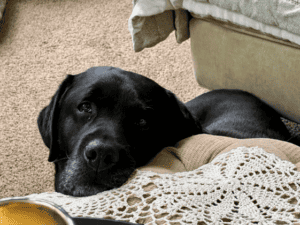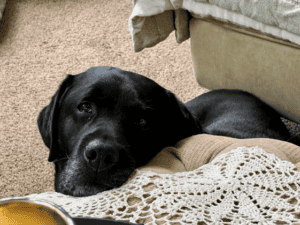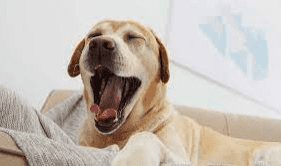
Labs have very special needs in older age than other breeds due to their size, their build, and their unique qualities. Helping them grow healthy is the first step, but then once they hit 6 or 7 they enter the SENIOR YEARS (a couple gray hairs ‘may’ appear–but not necessarily)—and many old/experienced breeders will tell you—it is critical from that age on (and what you’ve done up to that point) that will determine the length of your dog’s life and the QUALITY of its life. If your Lab is a family member, like ours, then you want them to be with you as long as possible, and to be able to join in normal daily activities and family fun for years and years to come without being left home, or left out of fun activities they once enjoyed.
Geriatric dogs have specific nutrient needs like amino acids to ensure adequate protein, and to maintain a healthy immune system, which fades with age. Fish oils are a great source of this! So it’s VERY important for preventing disease. We also need to combat aches and pains with nutrients to slow the aging process, help sore joints, and protect and preserve bone integrity. FACT: Most dogs are sent over the Rainbow Bridge due to the inability to get up or stand, in old age (thus, preventing them from ‘going out on their own’…so maintaining this strength is integral!) So a good, strong antioxidant is in order for all the former mentioned issues, as well as a glucosomine supplement—preferable with MSM and chondroitin, and vitamin C. (So, Labradors–technically a medium-sized dog, would need 500 mg daily)
Many dogs, also, eventually die of dehydration (believe it or not!)—either from inability to walk to water bowls—or just avoiding the pain of moving, therefore taking in less moisture by drinking less. If their teeth are in poor shape, they may also find cold water irritating. So less moisture makes them stiffer and causes degradation of the important organs of the body like the liver and kidneys. Simply adding a diet of at least 70% moisture can help to offset this and keep them moving longer. (That is because dry dog food diets only have a moisture content of about 10%) Older dogs, unfortunately, won’t make up for that with drinking water…)
Other body mechanisms that are affected by low moisture intake are cellular function and cellular formation. One has only to look at the following to understand the importance of an adequate supply of water in your pet’s body:
- Approximately two-thirds of an animal’s body is water.
- Brain is 90% water
- Bones are 22% water,
- Muscles have 75% water content
- Blood is 83% water.
Here’s what else water does for your pet:
- Transports nutrients and oxygen to the cells, moisturizes the air in the lungs , helps with metabolism , helps the organs to absorb nutrients.
- Regulates body temperature - detoxifies - protects and moisturizes the joints.


